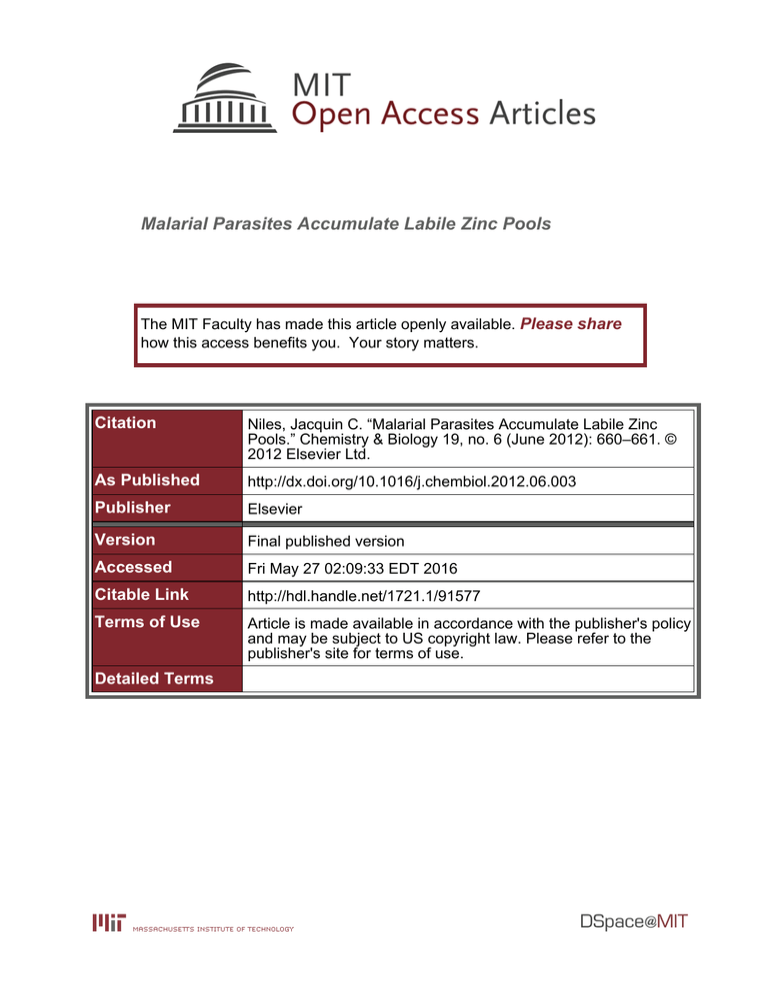
Malarial Parasites Accumulate Labile Zinc Pools
The MIT Faculty has made this article openly available. Please share
how this access benefits you. Your story matters.
Citation
Niles, Jacquin C. “Malarial Parasites Accumulate Labile Zinc
Pools.” Chemistry & Biology 19, no. 6 (June 2012): 660–661. ©
2012 Elsevier Ltd.
As Published
http://dx.doi.org/10.1016/j.chembiol.2012.06.003
Publisher
Elsevier
Version
Final published version
Accessed
Fri May 27 02:09:33 EDT 2016
Citable Link
http://hdl.handle.net/1721.1/91577
Terms of Use
Article is made available in accordance with the publisher's policy
and may be subject to US copyright law. Please refer to the
publisher's site for terms of use.
Detailed Terms
Chemistry & Biology
Previews
Malarial Parasites Accumulate Labile Zinc Pools
Jacquin C. Niles1,*
1Department of Biological Engineering, Massachusetts Institute of Technology, 77 Massachusetts Avenue, Room 56-341b, Cambridge,
MA 02139, USA
*Correspondence: jcniles@mit.edu
DOI 10.1016/j.chembiol.2012.06.003
The malarial parasite, Plasmodium falciparum, is an intracellular pathogen and partially dependent on
nutrient uptake for survival. In this issue of Chemistry & Biology, Marvin et al. demonstrate that zinc is essential for parasite growth and that the parasite maintains substantial labile cytosolic and mitochondrial
zinc pools.
Microbial pathogens require transition
metals for structural, catalytic, and signaling functions. While these roles have
been extensively studied in pathogenic
bacteria and fungi, fewer studies have
examined the contribution of transition
metals to human protozoan pathogen
biology. Given the essential roles these
metals play, a thorough and quantitative
understanding of the mechanisms governing the dynamics of uptake, subcellular distribution, and utilization should
provide basic insights that may be exploited for therapeutic purposes.
P. falciparum is an important example
of a human protozoan parasite. This
pathogen is responsible for the form of
malaria associated with the highest
rates of morbidity and mortality. To date,
studies of transition metal biology in
P. falciparum have focused predominantly on iron and, to a lesser extent,
copper metabolism (Rasoloson et al.,
2004). Several factors have contributed
to this emphasis. P. falciparum completes
a part of its complex life cycle inside
human red blood cells (RBCs). During this
period, the parasite imports a substantial
amount of hemoglobin (Hb) into a specialized digestive vacuole where Hb is
proteolytically degraded into peptides/
amino acids and the iron-containing
heme cofactor, which is predominantly
detoxified by polymerization into hemozoin (Francis et al., 1997). Despite the
large amount of iron that could be derived
from heme, the parasite is exquisitely
sensitive to iron chelators (Mabeza et al.,
1999). Similarly, copper chelation is inhibitory to parasite growth (Rasoloson et al.,
2004), suggesting these metals play critical biological roles.
Notably, key insights into iron metabolism in P. falciparum have been gained
through the use of complementary spectroscopic approaches. These modalities
have been invaluable in quantitatively
mapping the subcellular distribution of
various iron-containing species at high
spatial resolution in parasite-infected
RBCs (Bonifacio et al., 2008; Egan et al.,
2002; Kang et al., 2011). In this issue of
Chemistry and Biology, Marvin et al.
(2012) build on the theme of using
complementary spectroscopic techniques to gain key insights into metal
biology in P. falciparum. The authors use
X-ray fluorescence microprobe (XFM)
microscopy, confocal microscopy with
zinc-specific fluorescent sensors, and
inductively-coupled plasma-mass spectrometry (ICP-MS) to quantitatively
analyze the accumulation of zinc and
several other metals in P. falciparuminfected RBCs. They demonstrate that
infected RBCs accumulate intracellular
zinc at levels up to 4-fold above those in
uninfected RBCs as determined by XFM.
Zinc accumulation occurs in a stagedependent manner, with levels being
minimal in early-stage (rings), significantly
increased in mid-stage (trophozoites) and
maximal in late-stage (schizonts) parasites. Additionally, zinc appears to accumulate in both the parasite’s cytosol and
mitochondrion, reaching local concentrations up to 20-fold that in uninfected
RBCs. A substantial fraction of the zinc
pool is labile as determined by quantitative fluorescence imaging with the Zinbo5
sensor. Furthermore, the parasite is
susceptible to zinc restriction by the
potent chelating agent, TPEN, and zinc
supplementation reverses this effect.
Parasites treated with TPEN fail to accumulate a labile zinc pool, and their mitochondrial membrane potential is dissipated. Altogether, these data indicate
660 Chemistry & Biology 19, June 22, 2012 ª2012 Elsevier Ltd All rights reserved
that P. falciparum accumulates a labile
zinc pool and that zinc limitation by a
fairly specific and potent chelator induces
parasite death in a process that involves
mitochondrial dysfunction.
While the authors have focused on zinc
fluxes and characterize these in the most
detail, Marvin et al. (2012) provide additional insight into P. falciparum-induced
changes in the RBC ‘‘metallome’’. Using
ICP-MS, they demonstrate intracellular
increases in copper (2-fold), magnesium
(2-fold), and calcium (6-fold) above uninfected RBC levels. Interestingly, a significant increase in intracellular iron levels
in parasitized RBCs (14–15 mM) was
not detected. This reinforces the hypothesis that the labile iron pool upon which
the parasite is dependent is quite small
relative to what is potentially available.
The Marvin et al. (2012) paper raises
several key biological questions. What
are the mechanism(s) governing zinc
uptake and subcellular distribution in the
parasite? As the zinc concentration in
infected RBCs exceeds that in normal
RBCs, additional zinc must be acquired
from an extracellular source. The authors
propose a two-step process whereby
zinc is first imported into the RBC cytosol
by resident transporter(s), and subsequently into the parasite via parasitesynthesized transporter(s) (Figure 1).
They suggest the P. falciparum gene
PF07_0065 (PF3D7_0715900) as a candidate for zinc import based on a temporally
consistent transcriptional profile and its
29% identity to the mouse Znt2 transporter. However, no genetic, biochemical,
or cell biology data testing this hypothesis
is currently available. To speculate, bioinformatics analyses suggest that PF07_
0065 is a six transmembrane domain
protein lacking discernible N-terminal
Chemistry & Biology
Previews
signal peptide, apicoplast, or mitoprovide a high-resolution picture of
chondrial targeting sequences. As
the cell cycle phase most sensitive
zinc does not appreciably accumuto perturbation of the labile zinc
late in either the nucleus or the
pools.
Api
Nuc
digestive vacuole, PF07_0065 might
Overall, the study by Marvin et al.
2+
Zn
Mit
be predicted to localize to the para(2012) describes the intriguing
?
Zn2+
site cell membrane assuming it
phenomenon of an accumulated
DV
Parasite
plays a role in zinc trafficking. In
labile zinc pool in P. falciparum and
cytosol
RBC
this scenario, trafficking mechavulnerability of the parasite to zinc
Zn2+
cytosol
nisms to explain how zinc in the
restriction. The authors propose
PV
RBC cytosol enters the parasite’s
that this susceptibility may potenZn2+
cytosol and mitochondrion are still
tially be exploited in drug developZn2+
Legend
lacking. This speculative model is
ment efforts. Given the widespread
Resident RBC Zn2+ transporter
subject to the caveat that protein
resistance to current antimalarial
Putative parasite-synthesized Zn2+ transporters
trafficking targeting signals cannot
drugs, this may indeed represent
be predicted with complete cera new opportunity, especially upon
Figure 1. Putative Transport Routes for Zinc Uptake
tainty, and there are alternative
gaining a more complete underfrom the External Medium and Accumulation in the
mechanisms for protein subcellular
standing of the molecular mechaP. falciparum Cytosol and Mitochondrion Are
localization in P. falciparum and
nism(s) underlying zinc fluxes in the
Illustrated
Zinc transporters natively present on the RBC surface perhaps
other cell types. For example,
parasite.
together with unknown parasite-derived transporters exported
the Znt2 transporter in mouse
to the RBC membrane may mediate initial uptake of zinc into
mammary epithelial cells localizes
the RBC cytosol. Parasite-synthesized transporters could
then facilitate zinc transport across the parasitophorous
to the inner mitochondrial memREFERENCES
vacuole (PV) and into the parasite cytosol. Whether these are
brane despite the absence of a
general divalent metal or zinc-specific transport mechanisms
Bonifacio, A., Finaurini, S., Krafft, C., Paraclassical mitochondrial targeting
will be important to establish. The cytosolic and mitochondrial
pini, S., Taramelli, D., and Sergo, V. (2008).
sequence (Seo et al., 2011). If this
labile zinc pools may then dynamically communicate with each
Anal. Bioanal. Chem. 392, 1277–1282.
other.
Marvin
et
al.
(2012)
propose
that
the
PF07_0065
could
were also true in P. falciparum, this
be a zinc-specific transporter, but if and where it functions
Egan, T.J., Combrinck, J.M., Egan, J.,
could explain the partial accumulaalong the zinc transport route remain to be established. Api,
Hearne, G.R., Marques, H.M., Ntenteni, S.,
tion of zinc within the mitochonapicoplast; Mit, mitochondrion; Nuc, nucleus; PV, parasitoSewell, B.T., Smith, P.J., Taylor, D., van
phorous vacuole, which is a virtual space between the inner
drion. However, without invoking
Schalkwyk, D.A., and Walden, J.C. (2002).
parasite plasma membrane and the outer parasitophorous
Biochem. J. 365, 343–347.
targeting of PF07_0065 to multiple
vacuolar membrane derived from the RBC membrane during
compartments, it becomes difficult
parasite invasion.
Francis, S.E., Sullivan, D.J., Jr., and Goldto reconcile the observed subcelberg, D.E. (1997). Annu. Rev. Microbiol.
51, 97–123.
lular trafficking and distribution of
zinc with a single parasite-derived transKang, J.W., Lue, N., Kong, C.R., Barman, I.,
port mechanism. Further genetic and the more tightly protein-bound structural/ Dingari, N.C., Goldfless, S.J., Niles, J.C., Dasari,
biochemical studies will be needed to catalytic zinc pools. Consequently, direct R.R., and Feld, M.S. (2011). Biomed. Opt. Express
disruption of essential protein function 2, 2484–2492.
more fully address this question.
Another future challenge lies in defining may contribute to TPEN-induced toxicity. Mabeza, G.F., Loyevsky, M., Gordeuk, V.R., and
the essential zinc-dependent process(es) Therefore, whether perturbation of the Weiss, G. (1999). Pharmacol. Ther. 81, 53–75.
that are most reliant on the accumulated labile zinc pool per se versus direct depleMarvin, R.G., Wolford, J.L., Kidd, M.J., Murphy, S.,
labile zinc pool. Establishing a specific tion of zinc from essential proteins under- Ward, J., Que, E.L., Mayer, M.L., Penner-Hahn,
role for the mitochondrial zinc pool and lies TPEN-induced toxicity is presently J.E., Haldar, K., and O’Halloran, T.V. (2012).
Chem. Biol. 19, this issue, 731–741.
the circumstances under which it commu- unresolved. It will be informative to deternicates with the cytosolic pool will also be mine how selectively sequestering the Rasoloson, D., Shi, L., Chong, C.R., Kafsack, B.F.,
crucial. An important consideration worth labile zinc pool impacts parasite viability. and Sullivan, D.J. (2004). Biochem. J. 381,
keeping in mind is that TPEN is a potent, Furthermore, monitoring parasite growth 803–811.
cell-permeable chelator capable of per- kinetics over the course of the RBC devel- Seo, Y.A., Lopez, V., and Kelleher, S.L. (2011). Am.
turbing both the labile and to some extent opmental cycle during these studies will J. Physiol. Cell Physiol. 300, C1479–C1489.
Chemistry & Biology 19, June 22, 2012 ª2012 Elsevier Ltd All rights reserved 661








